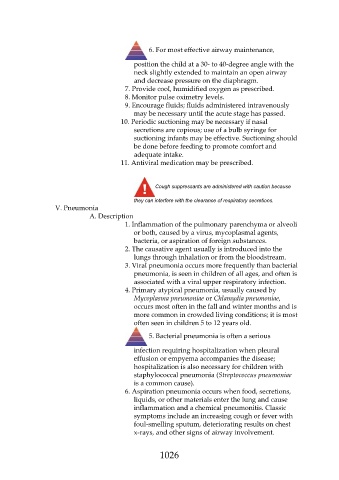Page 1026 - Saunders Comprehensive Review For NCLEX-RN
P. 1026
6. For most effective airway maintenance,
position the child at a 30- to 40-degree angle with the
neck slightly extended to maintain an open airway
and decrease pressure on the diaphragm.
7. Provide cool, humidified oxygen as prescribed.
8. Monitor pulse oximetry levels.
9. Encourage fluids; fluids administered intravenously
may be necessary until the acute stage has passed.
10. Periodic suctioning may be necessary if nasal
secretions are copious; use of a bulb syringe for
suctioning infants may be effective. Suctioning should
be done before feeding to promote comfort and
adequate intake.
11. Antiviral medication may be prescribed.
Cough suppressants are administered with caution because
they can interfere with the clearance of respiratory secretions.
V. Pneumonia
A. Description
1. Inflammation of the pulmonary parenchyma or alveoli
or both, caused by a virus, mycoplasmal agents,
bacteria, or aspiration of foreign substances.
2. The causative agent usually is introduced into the
lungs through inhalation or from the bloodstream.
3. Viral pneumonia occurs more frequently than bacterial
pneumonia, is seen in children of all ages, and often is
associated with a viral upper respiratory infection.
4. Primary atypical pneumonia, usually caused by
Mycoplasma pneumoniae or Chlamydia pneumoniae,
occurs most often in the fall and winter months and is
more common in crowded living conditions; it is most
often seen in children 5 to 12 years old.
5. Bacterial pneumonia is often a serious
infection requiring hospitalization when pleural
effusion or empyema accompanies the disease;
hospitalization is also necessary for children with
staphylococcal pneumonia (Streptococcus pneumoniae
is a common cause).
6. Aspiration pneumonia occurs when food, secretions,
liquids, or other materials enter the lung and cause
inflammation and a chemical pneumonitis. Classic
symptoms include an increasing cough or fever with
foul-smelling sputum, deteriorating results on chest
x-rays, and other signs of airway involvement.
1026

